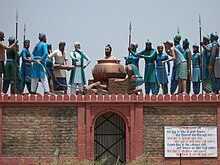
Decapitation is the total separation of the head from the body. Such an injury is invariably fatal to humans and most other animals, since it deprives the brain of oxygenated blood, while all other organs are deprived of the involuntary functions that are needed for the body to function.
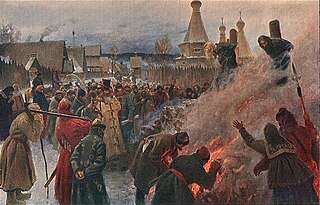
Death by burning is an execution, murder, or suicide method involving combustion or exposure to extreme heat. It has a long history as a form of public capital punishment, and many societies have employed it as a punishment for and warning against crimes such as treason, heresy, and witchcraft. The best-known execution of this type is burning at the stake, where the condemned is bound to a large wooden stake and a fire lit beneath.

The breaking wheel, also known as the execution wheel, the Wheel of Catherine or the (Saint) Catherine('s) Wheel, was a torture method used for public execution primarily in Europe from antiquity through the Middle Ages up to the 19th century by breaking the bones of a criminal or bludgeoning them to death. The practice was abolished in Bavaria in 1813 and in the Electorate of Hesse in 1836: the last known execution by the "Wheel" took place in Prussia in 1841. In the Holy Roman Empire it was a "mirror punishment" for highwaymen and street thieves, and was set out in the Sachsenspiegel for murder, and arson that resulted in fatalities.
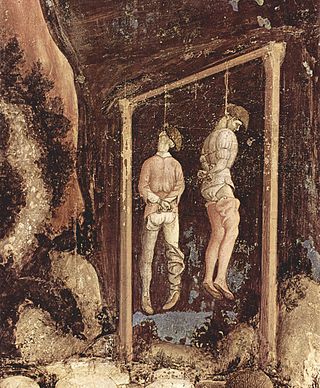
Hanging is killing a person by suspending them from the neck with a noose or ligature. Hanging has been a common method of capital punishment since the Middle Ages, and is the primary execution method in numerous countries and regions. The first known account of execution by hanging is in Homer's Odyssey. Hanging is also a method of suicide.
Cruel and unusual punishment is a phrase in common law describing punishment that is considered unacceptable due to the suffering, pain, or humiliation it inflicts on the person subjected to the sanction. The precise definition varies by jurisdiction, but typically includes punishments that are arbitrary, unnecessary, or overly severe compared to the crime.
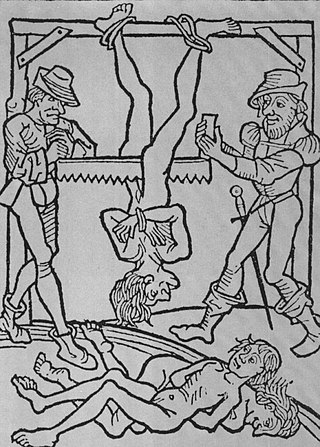
Death by sawing is the act of sawing or cutting a living person in half, either sagittally, or transversely.

Dismemberment is the act of completely disconnecting and/or removing the limbs from a living or dead being. It has been practiced upon human beings as a form of capital punishment, especially in connection with regicide, but can occur as a result of a traumatic accident, or in connection with murder, suicide, or cannibalism. As opposed to surgical amputation of limbs, dismemberment is often fatal. In criminology, a distinction is made between offensive dismemberment, in which dismemberment is the primary objective of the dismemberer, and defensive dismemberment, in which the motivation is to destroy evidence.

A kettle, sometimes called a tea kettle or teakettle, is a device specialized for boiling water, commonly with a lid, spout, and handle. There are two main types: the stovetop kettle, which uses heat from a hob, and the electric kettle, which is a small kitchen appliance with an internal heating element.

Ishikawa Goemon was a legendary Japanese outlaw hero who stole gold and other valuables to give to the poor. He and his son were boiled alive in public after their failed assassination attempt on the Sengoku period warlord Toyotomi Hideyoshi. His legend lives on in contemporary Japanese popular culture, often giving him greatly exaggerated ninja skills.

A mirror punishment is a penal form of poetic justice which reflects the nature or means of the crime in the means of punishment as a form of retributive justice—the practice of "repaying" a wrongdoer "in kind".

A public execution is a form of capital punishment which "members of the general public may voluntarily attend." This definition excludes the presence of only a small number of witnesses called upon to assure executive accountability. The purpose of such displays has historically been to deter individuals from defying laws or authorities. Attendance at such events was historically encouraged and sometimes even mandatory.

Bhai Dayala, also known as Bhai Dayal Das, was an early martyr of Sikhism. He was boiled alongside his Sikh companions Bhai Mati Das and Bhai Sati Das and the Ninth Guru, Guru Tegh Bahadur.

Bhai Mati Das, along with his younger brother Bhai Sati Das were martyrs of early Sikh history. Bhai Mati Das, Bhai Dayala, and Bhai Sati Das were executed at a kotwali (police-station) in the Chandni Chowk area of Delhi, under the express orders of Emperor Aurangzeb just before the martyrdom of Guru Tegh Bahadur. Bhai Mati Das was executed by being bound between two pillars and cut in two.
Capital punishment is forbidden in Switzerland under article 10, paragraph 1 of the Swiss Federal Constitution. Capital punishment was abolished from federal criminal law in 1942, but remained available in military criminal law until 1992. The last actual executions in Switzerland took place during World War II.
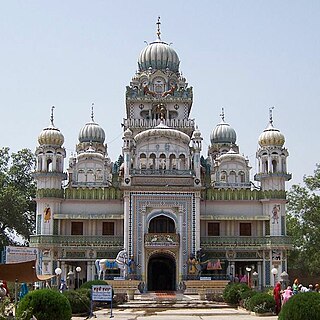
Gurdwara Mehdiana Sahib, also called the 'School of Sikh History' is a Sikh gurdwara located in the village of Mehdiana, just outside Mallha, near Jagraon in Ludhiana district, India.

Capital punishment was outlawed in the State of New York after the New York Court of Appeals declared it was not allowed under the state's constitution in 2004. However certain crimes occurring in the state that fall under the jurisdiction of the federal government are subject to the federal death penalty.
Richard Roose was accused in early 1531 of poisoning members of the household of the Englishman John Fisher, Bishop of Rochester, for which he was boiled to death. Nothing is known of Roose or his life outside the case; he may have been Fisher's household cook, or less likely, a friend of the cook, at Fisher's residence in Lambeth.
Decapitation was a standard method of capital punishment in pre-modern Islamic law. By the end of the 20th century, its use had been abandoned in most countries. Decapitation is still a legal method of execution in Saudi Arabia and Yemen. It is also a legal method for execution in Zamfara State, Nigeria under Sharia. In Iran, beheading was last used in 2001 according to Amnesty International, but it is no longer in use. In recent decades, extremist Salafi jihadist groups have used beheading as a method of killing captives and terror tactic.
Capital punishment is a legal penalty in Jordan. The country had a moratorium on capital punishment between 2006 and 2014. In late 2014 the moratorium was lifted and 11 people were executed. Two more executions followed in 2015, 15 executions took place in 2017 and one in 2021. The method of execution is hanging, although shooting was previously the sole method for carrying out executions.
